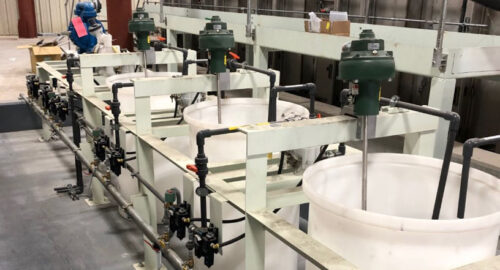Maintenance Tips and Tricks
Time-conserving, money-saving, aggravation-avoiding ideas for solving typical maintenance problems should be shared with others in the plant engineering profession. This idea-exchange concept serves as the basic philosophy for PLANT ENGINEERING magazine's 14th annual "Tips & Tricks" article.
|
Time-conserving, money-saving, aggravation-avoiding ideas for solving typical maintenance problems should be shared with others in the plant engineering profession. This idea-exchange concept serves as the basic philosophy for PLANT ENGINEERING magazine’s 14thannual “Tips & Tricks” article.
Details of this article were explained in the February issue. Readers were invited to submit shortcut maintenance methods or procedures used over the years for solving commonly encountered problems. A review panel examined the submittals and selected those appearing on the following pages.
All items not selected for this article will be considered for future appearance in Plant Engineering s monthly “Simple Solutions” department. A $35 honorarium is paid for each tip published.
Help pick the best tips
Review the 18 suggestions offered by others in the plant engineering profession, and vote for the five you believe are the most useful by writing the tip numbers on the special ballot next to p 48 . The item receiving the most votes will win the ” PLANT ENGINEERING Maintenance Tip of the Year Award.” The submitter will receive $1000 for the suggestion. The two runners-up will each receive $250.
Please return ballots by August 30, 2002.
Safety first
In all cases, even if not specifically mentioned in the descriptions, verify that the tip does not violate any relevant code, standard, or practice. Always use the appropriate safety equipment and procedures when applying the maintenance tips.
Handy pump
Problem: When soldering small, vertical, copper pipes, water is often present inside the pipe. This interferes with the joining process. How can the water level be lowered so soldering can be done?
Solution: Insert the riser tube on the spray nozzle from a bottle of window spray and pump out the water to the desired level. It beats trying to soak up the water with a rag or paper towel.
Contributor: Michael Hemenway, Teradyne, Nashua, NH
To Vote, Write 221 On Ballot
Connect the right hoses
Problem: Have you ever disconnected two sets of hoses on a machine and couldn’t remember which one connected to which one? How can you get the right hoses connected if you forgot to mark them?
Solution: Reverse the male and female ends of one set of hose disconnects. That done, it is impossible to get the hoses switched because both hoses will only go together the right way.
Contributor: Ron Hardison, AFG Industries, Victorville, CA
To Vote, Write 222 On Ballot
Keeping glue in its place
Problem: When glueing parts together with epoxy, it is not unusual for the epoxy to run and create a mess. How can the epoxy cement be kept in place and produce a neat assembly when dry?
Solution: Shape a fillet at the joint of the two pieces to be joined. Make the fillet out of filings from the base material or from baking soda. Add the epoxy cement to the fillet and wait about 30 sec for it to set. Be sure of the fillet shape because the glued material will be hard to reshape after the cement dries.
Contributor: Don Eisermann, Trane Div., American Standard, LaCrosse, WI
To Vote, Write 223 On Ballot
Sizing up a location alone
Problem: “Hold your finger/hand right here so I can see what that position looks like.” Sometimes stepping back to survey the placement of fixtures or hardware to ensure the best placement requires an assistant. How can this be done if you are alone?
Solution: A pocketsize magnetic pickup tool (with a flat end on the magnet) can be stuck to a machine surface to provide an easily seen indicator. A small metal plate can be used as a base for standing upright on nonmagnetic, horizontal surfaces.
Contributor: Daniel Vokovich, Manufacturing Engineer, Invacare, Corp., Sanford, FL
To Vote, Write 224 On Ballot
Gentle jaw grip
Problem: Vise jaws can leave marks on soft parts. To avoid this, makeshift soft jaws are made out of brass or aluminum. Sometimes, they too can leave marks. What can be done to easily and quickly provide nonmarking vise jaws?
Solution: For easy, quick, and inexpensive “soft jaws” on a vise, cut flexible, magnetic strips to the jaw shape. When not in use, the strips can be stored on the side of the vise, readily accessible the next time they are needed.
Contributor: Jerry Miller, New Product Design, The Hammerblow Corp., Wausau, WI
To Vote, Write 225 On Ballot
Welding fog-free
Problem: Often, when welding in cold, humid, or wet weather, the inside lens of a welding hood fogs up. What can be done, aside from removing the helmet and wiping it off, to prevent the lens from fogging up?
Solution: Clean the inside of the welding hood lens with shaving cream. This prevents the lens from fogging up and makes the inside of the helmet smell good. Use shaving cream, gel will not work.
Contributor: David E. Scott, Metaldyne-Shaft Operations, Minerva, OH
To Vote, Write 226 On Ballot
Keep screws handy
Problem: When using a lot of fastening screws, it is time-consuming to reach for them one at a time from a box. Is there a better way to have the screws handy while doing this work?
Solution: Tape a magnet to the back of a drill. Dip the drill into the box of screws and dozens of them will stick to the magnet. They are now convenient to select and do the job.
Contributor: Ralph Dewey, BP Solvay Polyethylene North America, Deer Park, TX
To Vote, Write 227 On Ballot
Gaskets stay put
Problem: Sometimes gaskets have to be installedin unusual and/or difficult locations. They may be awkward or impossible to hold in place while installing bolts. How can you get a gasket to stay in place when installing it in such a situation and adhesives can’t be used?
Solution: Hold the gasket in location against one surface and tie it in place with pieces of string located in opposite holes. Install bolts in the remaining holes, drawing the two surfaces close to each other. Cut and remove the strings. Install the remaining bolts and the job is done.
Contributor: Frank Anderer, CPE, Bell & Gossett, Morton Grove, IL
To Vote, Write 228 On Ballot
Do-it-yourself magnetic screwdriver
Problem: You have to start a screw in an awkward place. There is no way to hold the screw and you don’t have a holding screwdriver. How can you make a magnetic screwdriver?
Solution: Attach two bar magnets to the tip of an ordinary screwdriver using a piece of bicycle inner tube. The magnets can easily be put on or taken off as required.
Contributor: Tom Paloin, Photronics, Inc., Brookfield, CT
To Vote, Write 229 On Ballot
Test fuses quickly
Problem: Have you ever gone to the electrical supply room to get a replacement fuse only to find when you got back to the equipment that the fuse was bad? How can you check a fuse quickly and safely before leaving the supply room?
Solution: Mount a doorbell transformer, a 24 V light socket and bulb, and two metal bars about 1/8 x 1 x 12 in. long on a sheet of plywood. Mount the bars in a V-shape with 1/4-in. space at one end and a 12-in. space at the other end. Wire the circuit as shown. Now most any size fuse can be checked safely in the 24-V circuit.
Contributor: Dave White, Maintenance & Facility Manager, Titan Wheel Corp. of Illinois, Quincy, IL
To Vote, Write 230 On Ballot
A new twist on Teflon tape
Problem: Many times the packing on a valve, such as a ball valve, requires a rope type material. If you only have pipe-sealing Teflon tape, how can you repack the ball valve?
Solution: Pay out some Teflon tape from the roll it’s on. Twist it so it forms a rope. It can now be used to repack the valve stem until the proper packing can be installed.
Contributor: Brian Gifford, Rich Products, Hamburg, NY
To Vote, Write 231 On Ballot
Drill through the center of round stock
Problem: Holes must be drilled through the center of round stock. Is there a way to determine where the center is quickly and easily?
Solution: Mark the axial location of the hole and clamp the part in the drill press vise. Place a thin strip of metal (6 in. steel rule, hacksaw blade, etc.) on the part. With the drill press off, lower the drill bit onto the metal strip, lightly squeezing it. Move the vise until the metal strip is level. That is the center of the round part.
Contributor: Steve Bailey, Maintenance Technician, Honeywell, Conway, SC
To Vote, Write 232 On Ballot
Another use for socket head screws
Problem: Some assemblies have a multitude of little screws that need to be undone and retightened when making repairs. Is there a way to do this quickly without special tools?
Solution: The sockets in a socket wrench set are not suited for repetitive work such as this. Use socket head cap screws as sockets to do the work. Chuck one in a drill and proceed. For example, a 3/8-in. cap screw has a 5/16-in. internal hex hole, which is a common head size for small screws.
Contributor: David York, Mechanical Engineer, Texarkana, TX
To Vote, Write 233 On Ballot
Make big filters
Problem: Filters placed at the inlet to return air ducts help keep them clean. Sometimes these inlets can be large, and finding the right size filter is difficult. How can I get the right size filter?
Solution: Purchase a roll of disposable filter material. Cut it to the size required. Use fencing material with large openings, and cut it larger than the duct opening to support the filter material.
Contributor: Michael E. Sipe, Maintenance Supervisor of Buildings and Grounds, Tight Industries, York, PA
To Vote, Write 234 On Ballot
Get the picture
Problem: A new piece of automated machinery was installed and set up for production. Plant engineers had trouble diagnosing some intermittent problems in the equipment. How could the problems be analyzed without someone being around the machine constantly?
Solution: A video camera was mounted on a tool post to monitor a specific area of the machine for several hours at a time. The tool post was adjustable, so the camera could observe different areas of concern. A tape was made of the equipment while running and was played back at slow speed to observe and solve the problem.
Contributor: Philip M. Underwood, Process Engineer, Rogers Corp., North Brookfield, MA
To Vote, Write 235 On Ballot
Inflating new tires
Problem: New hand trucks and carts with pneumatic tires are often shipped with little or no air pressure. This often leaves the tire loose on the rim. No matter how hard you try, you can’t get the tire to seal properly and inflate. Is there a simple way to inflate the tire?
Solution: Take a belt or dog leash and wrap it around the outside center of the tread. Pull the belt tight until the center of the tire collapses, forcing the sidewalls to bulge out against the rim. Connect an airline to the tire valve and begin inflating the tire. As the air pressure begins forcing the tire against the belt, slowly release belt force until the tire is completely inflated.
Contributor: D. Barry Self, RJ Reynolds, Winston-Salem, NC
To Vote, Write 236 On Ballot
Cut filtration costs
Problem: Cooling water for welders and ethylene glycol mixtures for cooling air compressors must be filtered. Some industrial filters can cost up to $3000 and replacement cartridges $150. Can these fluids be filtered less expensively?
Solution: Try a swimming pool filter that uses sand as the filter media, eliminating the filter cartridge. Cost is about $400. The pool filter can produce 30 to 40 gpm at 35 psi and filter down to 20 to 50 microns. When the sand gets dirty, it can be back flushed to a waste line.
Contributor: Tim Weist, Facilities Manager, Almco Steel Products, Bluffton, IN
To Vote, Write 237 On Ballot
Identify your tools
Problem: Everyone brings his or her own tools to a work site. In many instances, they look identical. How can you tell which tools are yours?
Solution: Wrap your tools with color-coded, self-fusing silicone tape. Since the tape does not use any adhesive to bind, it will not come off under normal handling. The tape comes in various colors and can be used to identify tools from other workers.
Contributor: David A. Davies, Indumar Products, Inc., Houston, TX
To Vote, Write 238 On Ballot
About Tips & Tricks
Plant Engineering magazine considers “Tips & Tricks” an ongoing editorial project. If you come up with a maintenance idea that meets the time-conserving, money-saving, aggravation-avoiding criteria, send it along immediately while the thought and intent to share the information are fresh. Drawings or photos should also be provided, if possible.
The submittal will be considered for future “Tips & Tricks” articles and the monthly “Simple Solution” column. Any item published earns the submitter $35.
Submit suggestions to Plant Engineering Tips & Tricks, 2000 Clearwater Drive, Oak Brook, IL 60523; fax 630-288-8781; emailjfoszcz@reedbusiness.com.
Do you have experience and expertise with the topics mentioned in this content? You should consider contributing to our CFE Media editorial team and getting the recognition you and your company deserve. Click here to start this process.





